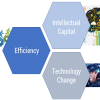Strategic advice to leverage new technologies
Technology is at the heart of nearly every enterprise, enabling new business models and strategies, and serving as the catalyst to industry convergence. Leveraging the right technology can improve business outcomes, providing intelligence and insights that help you make more informed and accurate decisions. From finding patterns in data through data science, to curating relevant insights with data analytics, to the predictive abilities and innumerable applications of AI, to solving challenging business problems with ML, NLP, and knowledge graphs, technology has brought decision-making to a more intelligent level. Keep pace with the technology trends, opportunities, applications, and real-world use cases that will move your organization closer to its transformation and business goals.
Insight
Digital architecture involves internal stakeholders shifting paradigms from thinking of solutions from within to fully incorporating external stakeholders (customers) in the solution design process. Different organizations leverage various approaches to achieve this paradigm shift, but one of the main drivers of digital architecture is customer centricity. This Advisor highlights this driver as well as some of the other most critical ones.
This issue of Cutter Business Technology Journal (CBTJ) continues the conversation we began in our last CBTJ and focuses on blockchain technology adoption beyond cryptocurrencies and financial services. The authors explore areas such as energy and utilities and government and present real examples of successful DLT implementations. They share their practical experiences in overcoming and addressing some of the known issues with blockchain projects.
In the era of open source projects, which enable deep analysis of code, it is doubtful that we can maintain privacy through the ages. Publicly accessible code facilitates consistent improvements and debugging through the regular scrutiny of accessible data. At the same time, it also increases the possibility of finalizing an attack on the network, causing losses and a reduction in trust. As a result, several companies now focus on analyzing blockchains.
Sizing, Structuring, and Fine-Tuning Your EA Function
Virtually every organization in a developed part of the world critically depends on IT for running its business processes. Having a dedicated enterprise architecture function responsible for planning all organizational changes involving IT has thus became a necessity for most companies, with the exception of the smallest ones. But how should organizations design their architecture functions? How many architects do organizations need, and what specific positions should they occupy?
Digital competitors have raised the bar and are forcing incumbents from virtually every industry into huge transformation programs. To win this race for digitalization, incumbents are investing vast amounts of resources into multi-year programs that require them to change the engine with the train still rolling. This requires executive teams to manage many challenges and produce multiple results that are either different than expected or diluted.
Mike Rosen’s webinar “Architecture for Digital Business” explored how to support your business transformation by taking an architectural approach to strategy. Here are four questions we asked Mike at the end of the webinar that you may also be considering.
Design Thinking to the Rescue!
Transformation of a company and managing through change are inherently difficult. The inclusion of a digital component in this transformation effort makes the work that much more challenging, even for the sharpest and most visionary of executives. Companies undertaking digital transformation, in our opinion and based on our experience, face four major challenges that we believe design thinking tools can help overcome. In this Advisor, we explore two of these challenges and explain how design thinking can provide solutions.
This issue of The Cutter Edge explores how the next two to three years will be important for blockchain in terms of implementing proper regulations and standards to enable wider adoption; why architecture must refocus on three core principles to play a pivotal role in business transformation, and more!



















